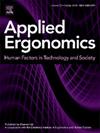Assessing cognitive load through eye metrics in in-motion vs. stationary environments
IF 3.4
2区 工程技术
Q2 ENGINEERING, INDUSTRIAL
引用次数: 0
Abstract
Objective
Quantifying cognitive load during whole-body motion is crucial for professions such as aircraft pilots and paramedics. This study incorporates eye metrics to monitor cognitive load changes during aiming tasks with different levels of difficulty (ID) while the participant was either stationary or experiencing whole-body motion (in-motion condition).
Method
25 participants completed reciprocal aiming tasks under both in-motion and stationary conditions. The IDs were modified by altering target distances and sizes. Eye metrics, including pupil size, blink rate, fixation dispersion, and eye saccadic movements, were analyzed.
Results
Under in-motion conditions, significantly larger pupil dilation was observed by more than 100 %; Blink rate decreased by 27 % for difficult tasks; Participants displayed significantly larger fixation dispersion by 29 %. Participants’ eyes frequently overshot targets while scanning between targets, followed by a series of corrective adjustments, for both conditions.
Conclusions
The in-motion condition significantly increased cognitive load, exaggerated pupil dilation, suppressed eye blinks, and intensified fixation dispersion.
Applications
Eye metrics assess cognitive load in moving environments, offering reliable tools to study the effects of motion. This aids in developing training protocols to minimize negative impacts on individuals working under whole-body motion conditions.
在运动与静止环境中通过眼测量评估认知负荷
目的对飞行员、医护人员等职业进行全身运动认知负荷量化研究。本研究采用眼球测量来监测不同难度(ID)的瞄准任务中认知负荷的变化,而参与者要么静止,要么经历全身运动(运动状态)。方法25名被试分别在运动和静止条件下完成相互瞄准任务。通过改变目标的距离和大小来修改id。眼睛指标,包括瞳孔大小、眨眼频率、注视分散度和眼球跳动进行了分析。结果在运动状态下,瞳孔扩张明显大于100%;困难任务的眨眼率降低27%;参与者的注视分散度显著提高了29%。在两种情况下,参与者的眼睛在扫描目标之间时经常会越过目标,然后进行一系列的校正调整。结论运动状态显著增加认知负荷,瞳孔扩张加剧,眨眼抑制,注视分散加剧。applicationeye指标评估运动环境中的认知负荷,为研究运动的影响提供可靠的工具。这有助于制定训练方案,以尽量减少对个人在全身运动条件下工作的负面影响。
本文章由计算机程序翻译,如有差异,请以英文原文为准。
求助全文
约1分钟内获得全文
求助全文
来源期刊

Applied Ergonomics
工程技术-工程:工业
CiteScore
7.50
自引率
9.40%
发文量
248
审稿时长
53 days
期刊介绍:
Applied Ergonomics is aimed at ergonomists and all those interested in applying ergonomics/human factors in the design, planning and management of technical and social systems at work or leisure. Readership is truly international with subscribers in over 50 countries. Professionals for whom Applied Ergonomics is of interest include: ergonomists, designers, industrial engineers, health and safety specialists, systems engineers, design engineers, organizational psychologists, occupational health specialists and human-computer interaction specialists.
 求助内容:
求助内容: 应助结果提醒方式:
应助结果提醒方式:


